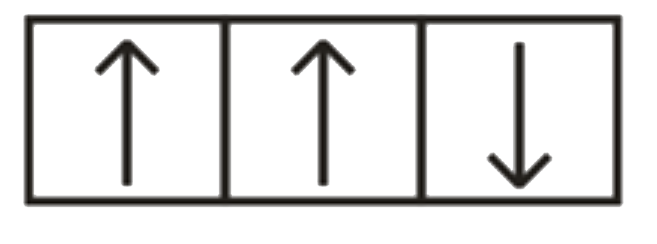Which of the following electronic configurations can leads to the formation of high spin and low spin octahedral complexes ?
d1
d2
d3
d4
The correct Answer is:D
To determine which electronic configurations can lead to the formation of high spin and low spin octahedral complexes, we need to analyze the distribution of d-electrons in the d-orbitals of transition metal ions in an octahedral field.
1. Understanding Octahedral Complexes:
In an octahedral field, the five d-orbitals split into two energy levels: the lower energy set (t2g) which consists of three orbitals, and the higher energy set (eg) which consists of two orbitals.
2. Filling of d-Orbitals:
Electrons will fill the lower energy t2g orbitals first before occupying the higher energy eg orbitals. This is in accordance with Hund's rule, which states that electrons will fill degenerate orbitals singly before pairing up.
3. Identifying High Spin and Low Spin Configurations:
- High Spin Complexes: These occur when the energy difference between the t2g and eg orbitals (Δ) is small, allowing electrons to occupy the higher energy eg orbitals rather than pairing in the t2g orbitals. This typically occurs with weak field ligands.
- Low Spin Complexes: These occur when Δ is large, causing electrons to pair up in the t2g orbitals before occupying the eg orbitals. This typically occurs with strong field ligands.
4. Analyzing Electron Configurations:
- For d1, d2, and d3 configurations: All electrons will occupy the t2g orbitals. These configurations will always lead to high spin complexes since there are no higher energy electrons to occupy the eg orbitals.
- For d4 configuration: There are two possibilities:
- High spin: 3 electrons in t2g and 1 in eg (one unpaired electron in eg).
- Low spin: 4 electrons in t2g (all paired).
- For d5 configuration: This will always be high spin since all five electrons will occupy the t2g and eg orbitals singly.
- For d6 configuration: Similar to d4, it can be either high spin (4 in t2g and 2 in eg) or low spin (6 in t2g, all paired).
- For d7 configuration: It can also be both high spin and low spin depending on the ligand field strength.
- For d8 and d9 configurations: These will generally lead to low spin configurations as the electrons will pair up in the lower energy orbitals.
5. Conclusion:
- High spin configurations can occur for d1, d2, d3, d4 (high spin), d5, d6 (high spin), d7 (high spin), and d8 (typically low spin).
- Low spin configurations can occur for d4 (low spin), d6 (low spin), d8, and d9.
In an octahedral field, the five d-orbitals split into two energy levels: the lower energy set (t2g) which consists of three orbitals, and the higher energy set (eg) which consists of two orbitals.
Electrons will fill the lower energy t2g orbitals first before occupying the higher energy eg orbitals. This is in accordance with Hund's rule, which states that electrons will fill degenerate orbitals singly before pairing up.
- High Spin Complexes: These occur when the energy difference between the t2g and eg orbitals (Δ) is small, allowing electrons to occupy the higher energy eg orbitals rather than pairing in the t2g orbitals. This typically occurs with weak field ligands.
- Low Spin Complexes: These occur when Δ is large, causing electrons to pair up in the t2g orbitals before occupying the eg orbitals. This typically occurs with strong field ligands.
- For d1, d2, and d3 configurations: All electrons will occupy the t2g orbitals. These configurations will always lead to high spin complexes since there are no higher energy electrons to occupy the eg orbitals.
- For d4 configuration: There are two possibilities:
- High spin: 3 electrons in t2g and 1 in eg (one unpaired electron in eg).
- Low spin: 4 electrons in t2g (all paired).
- For d5 configuration: This will always be high spin since all five electrons will occupy the t2g and eg orbitals singly.
- For d6 configuration: Similar to d4, it can be either high spin (4 in t2g and 2 in eg) or low spin (6 in t2g, all paired).
- For d7 configuration: It can also be both high spin and low spin depending on the ligand field strength.
- For d8 and d9 configurations: These will generally lead to low spin configurations as the electrons will pair up in the lower energy orbitals.
- High spin configurations can occur for d1, d2, d3, d4 (high spin), d5, d6 (high spin), d7 (high spin), and d8 (typically low spin).
- Low spin configurations can occur for d4 (low spin), d6 (low spin), d8, and d9.
Topper's Solved these Questions
- COORDINATION COMPOUNDSBook:R SHARMAChapter:COORDINATION COMPOUNDSExercise:Question Bank (Building the knowledge)
Explore 38 Videos
- COORDINATION COMPOUNDSBook:R SHARMAChapter:COORDINATION COMPOUNDSExercise:Archives
Explore 56 Videos
- CHEMISTRY IN EVERYDAY LIFEBook:R SHARMAChapter:CHEMISTRY IN EVERYDAY LIFEExercise:Archives
Explore 11 Videos
- ELECTROCHEMISTRYBook:R SHARMAChapter:ELECTROCHEMISTRYExercise:Follow-up Test 11
Explore 7 Videos
Similar Questions
Knowledge Check
Which of the following electronic configurations has zero spin multiplicity?
A B
B C
C D
D
Which of the following electronic configurations have spin multiplicity equal to zero ?
A B
B C
C D
D
Which of the following metal fons cannot form both high spin and low spin octahedral complexes
(B)
(C)
(D)ATt3+BCo2+CFe2+DCu2+
For which of the following dn configuration of octahedral complex(es), cannot exist in both high spin and low spin forms?
View SolutionFor which of the following dn configuration of octahedral complex(es), cannot exist in both high spin and low spin forms?
View SolutionFor which of the following dn configuration of octahedral complex(es), cannot exist in both high spin and low spin forms ?
(P)d3 (Q)d5
(R)d6 (S)d8
View SolutionFor which of the following dn configuration of octahedral complex(es), cannot exist in both high spin and low spin forms ?
(P)d3 (Q)d5
(R)d6 (S)d8
View SolutionWhich of the following pairs of d-electron configuration exhibit both low and high spin tetrahedral complex
View Solution

